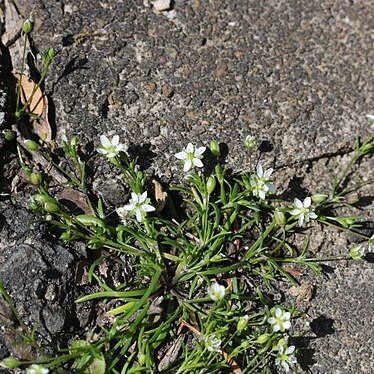Herbs annual or biennial. Stems tufted, suberect or creeping, 5--20 cm tall, slender, basally branched, apically glandular hairy. Leaves linear, 5--20 × 0.8--1.5 mm, glabrous, connate at base, acute and minutely spine tipped. Flower solitary, terminal or axillary. Pedicel erect, 1--2 cm, sparsely pubescent. Sepals 5, ovate-elliptic, ca. 2 mm, glandular hairy, apex obtuse. Petals 5, ovate, slightly shorter than sepals, apex rounded. Stamens 5. Ovary ovoid; styles 5. Capsule globose, slightly longer than sepals, 5-valved. Seeds brown, reniform-globose, not grooved, sharply tuberculate. Fl. Apr--May, fr. May--Jun. 2n = 46, 64.
From Japan and China, is casually intr. in N.Y., Conn., and Mass., and may be expected elsewhere. Much like S. decumbens in aspect, it differs in its slightly succulent lvs, glandular-hairy (at least distally) pedicels, shorter, more globose fr, and dark brown, evidently muricate, plump seeds without a dorsal groove.
A herb. It grows each year from seeds. The stems are tufted and can be creeping. It grows 5-20 cm tall. The leaves are narrow and 5-20 mm long by 1-2 mm wide.

